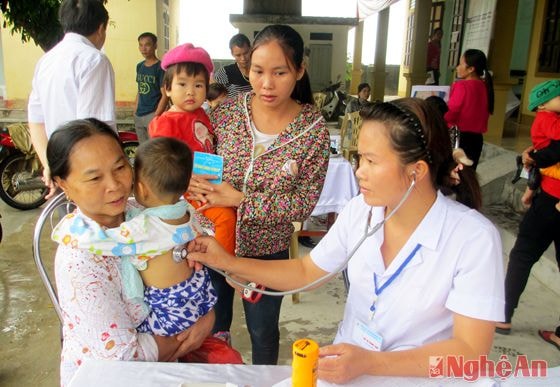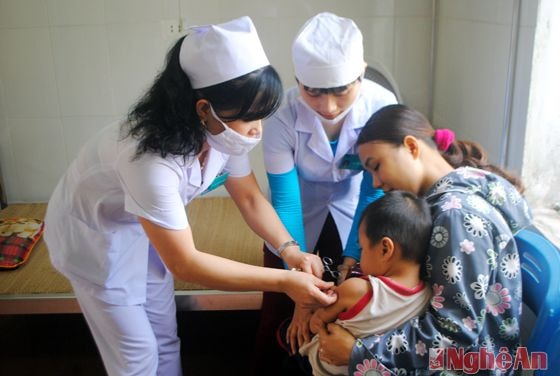Transformation in pediatric healthcare
(Baonghean) - Implementing the target set by the Resolution of the 17th Provincial Party Congress: "the annual rate of children under 1 year old fully vaccinated reaches over 95%", in recent years, localities in the province have made efforts to strengthen measures to increase the rate of children eligible for vaccination in the area. Thanks to that, this number has increased every year, in 2014, the rate of children fully vaccinated "reached the milestone" of 95%.
Propaganda is the spearhead
Over the years, Yen Thanh has always been a bright spot in child vaccination. The vaccination rate of children under 1 year old in this locality has always been high, from 96% in 2011, increasing to 97% in 2013 and reaching over 97% by the end of 2014. In Tay Thanh commune, there are 16 hamlets, including 6 Catholic hamlets, the annual vaccination rate of the commune has always met and exceeded the target (in 2014 it reached 98%).
According to Dr. Tran Kim Thanh, Head of Tay Thanh Commune Health Station, in the past, many households, especially Catholic households, often had the concept of "God created elephants and God created grass", so they did not pay much attention to children's health. Therefore, the commune focused on organizing a team of commune health workers, coordinating with village health workers to do direct communication work at each household, combined with integrating into the activities of the Women's Union, population specialists, etc. In addition, to avoid missing children in vaccination rounds, the commune also assigned village health workers to be directly present at the vaccination site to review the list of children in the area under their management, promptly reporting to the commune's expanded vaccination specialist to make a list of additional vaccinations for the children. The support and close monitoring of the village health team has really been effective in maintaining and improving the rate of children vaccinated in the area.
 |
| Screening for children before vaccination at Quynh Hong Commune Health Station (Quynh Luu). Photo: Tu Thanh |
Going up to the mountainous district of Quy Chau, where people's lives are still difficult, but vaccination for children has improved significantly. A typical example is Chau Phong commune, a remote commune where the national grid has not yet reached the villages. Five years ago, the vaccination rate in the commune was very low, only about 85%. Chau Phong is a mountainous commune, with difficult roads, houses far apart, no electricity... so propaganda work is always difficult. Over 90% of the commune's population is Thai ethnic group, people still maintain ethnic customs and practices, often "khai, che" when children are sick and rarely go to the commune health station.
Thanks to the efforts of the political system and the medical team, the vaccination rate of children in Chau Phong has increased by 10%. Ms. Vi Thi Chuyen, Head of the Commune Health Station, excitedly said: "We actively coordinate with the medical staff in 19 villages, visiting each family every month to propagate to parents and pregnant mothers about the disease prevention effects of vaccination. At the same time, we coordinate with village elders and village chiefs to integrate vaccination propaganda content into village meetings. With the method of "slow and steady wins the race", direct communication has contributed to raising people's awareness of taking care of children's health. Up to now, in Chau Phong, every month on the vaccination day, parents voluntarily take their children to vaccination points."
 |
| Vaccination for children in Hung Dung ward (Vinh city). Photo: D.N |
Vinh City also faces its own difficulties in vaccinating children, because the city's residents have easy access to information sources, so in previous years when there was information about post-vaccination complications that occurred when children were vaccinated with Quinvaxem vaccine in other provinces, many parents were afraid to let their children get vaccinated. Therefore, the city's vaccination rate decreased significantly: from 98.9% (in 2012) to 90.9% (in 2013).
To mobilize people to vaccinate their children, the city has implemented many synchronous measures. The City Health Center has strengthened coordination with wards and communes, mobilized the participation of organizations to promote communication throughout the area so that people understand the benefits of vaccinating children; creating a "vaccination festival" on the 10th of every month. At the same time, organize training to improve professional capacity for commune and ward health staff on safe vaccination prevention. Implement industry regulations on safe vaccination procedures: according to a one-way chain (screening examination, vaccination, post-vaccination monitoring). Therefore, in the past, wards often organized vaccinations within one day, but now they are organized in batches to not miss any children and ensure the correct safe vaccination procedures. The City Health Center also connects with hospitals in the area to coordinate timely handling when incidents occur. Thanks to that, the safety of vaccination is ensured, gradually "convincing" people to vaccinate their children. In 2014, the expanded vaccination rate in Vinh City increased significantly, reaching 98.6%".
Increase in quantity, ensure in quality
In general, in the whole province in recent years, the annual expanded vaccination rate has met the set plan and is safe; specifically, in 2011 it reached 98.9%, in 2012 it reached 95.2%. In 2013 alone, some localities' vaccination rates decreased compared to the previous year, but in the whole province the expanded vaccination rate reached 91%.
The main reason is that since July 2010, when Quinvaxem vaccine was introduced, the situation of post-vaccination reactions has increased, so people are hesitant to take their children for vaccination. However, in 2014, the vaccination rate in the districts has increased again, with tens of thousands of safe injections, reaching an estimated 95% of children under 1 year old fully vaccinated. It is worth noting that people's awareness of disease prevention for children has increased not only in the city and the plain districts, but also in the mountainous areas. Thanks to that, the work of child health care in recent years has improved significantly.
Talking about that result, Doctor Hoang Ngoc Dan, Deputy Head of the Department of Infectious Disease Control, Vaccines and Biologicals - Provincial Center for Preventive Medicine said: "In the past 5 years, in our province, diseases in the expanded immunization program such as: polio in children have been eliminated, neonatal tetanus has been eliminated, and measles is being controlled and eliminated.
In addition, diseases such as diphtheria, whooping cough, tetanus have decreased significantly, the number of cases recorded each year is very low. In particular, Japanese encephalitis in children has decreased significantly; 5 years ago, the number of cases recorded each year was nearly 100, but now there are only 10 cases. For example, in the mountainous district of Que Phong, although the area has 89% of Thai, Mong, and Kho Mu ethnic people living, in 2014, the vaccination rate reached 96%. In the past 5 years, vaccination safety has been ensured, there have been no cases of children contracting diseases in the expanded vaccination program. In some communes, the vaccination rate exceeded the target, such as: Thong Thu, Tien Phong, Quang Phong...
As for Quy Chau district, although it is a mountainous area with over 70% of Thai people, in the past 5 years, the overall vaccination rate for children in Quy Chau has increased by 2% each year, reaching 97%. According to Mr. Hun Vi Truong, Director of Quy Chau District Medical Center, to achieve that result, in addition to focusing on direct communication, the important thing is still "making people understand". That is proven by the fact that the rate of children contracting diseases in the expanded immunization program is very low, only a few cases each year. Vaccination safety in the district is always guaranteed, with no adverse events occurring after vaccination. Thanks to that, people are increasingly aware that vaccinating children is a right".
Thus, the target according to the Resolution of the 17th Provincial Party Congress "Strive annually: The rate of children under 1 year old fully vaccinated with all types of vaccines reaches over 95%" has "reached the target". In the coming time, to promote the achieved results, according to Dr. Hoang Ngoc Dan, the health sector will continue to promote the implementation of solutions: First of all, communication work is flexibly deployed in accordance with the characteristics of each locality, village, and hamlet. Diversify communication forms such as banners, slogans, through loudspeakers in villages and hamlets...
For some mountainous districts, some propaganda discs in ethnic languages (Thai, Mong) have been provided to serve propaganda work. It is necessary to promote and expand to raise awareness of people in ethnic minority areas about expanded immunization work for children. At the same time, strictly implement the regulations of the industry, and tighten vaccination safety activities. Each session only vaccinates 50 children. At vaccination sites, it is necessary to prepare facilities such as monitoring rooms, medicine equipment, and materials for post-vaccination treatment. Currently, 20 districts, cities, and towns have been equipped with vaccine storage plugs to each commune and ward. The industry continues to deploy training to improve professional knowledge on vaccination for grassroots medical staff; each year, there are usually 1-2 sessions/district to ensure good vaccination safety work. Only then will people feel secure to exercise their right to vaccinate their children.
However, the current vaccination work for children still faces challenges: The awareness of people in some mountainous, remote and isolated areas about child health care is still limited due to customs, practices and limited qualifications... Difficulties in transportation in some villages and hamlets affect propaganda and mobilization work and the transportation of vaccines to villages and hamlets is still inadequate; some places do not have electricity to use means to preserve vaccines... Therefore, there are still cases of children contracting some diseases in the expanded immunization program; for example, in 2014, Nghe An recorded nearly 896 cases of children with measles-like rash fever in some districts in the area.
To maintain both the quantity and quality of expanded immunization activities, it requires the continuous efforts of medical staff at all levels. Faced with the increasing demand for the quality of immunization services, staff participating in expanded immunization activities at facilities must always be aware of their responsibility in properly implementing safe immunization procedures. In addition to propaganda and dissemination to people about the disease prevention effects of vaccination, it is necessary to focus on propaganda on how to prevent contraindications, as well as how to handle post-vaccination reactions...
Dinh Nguyet






